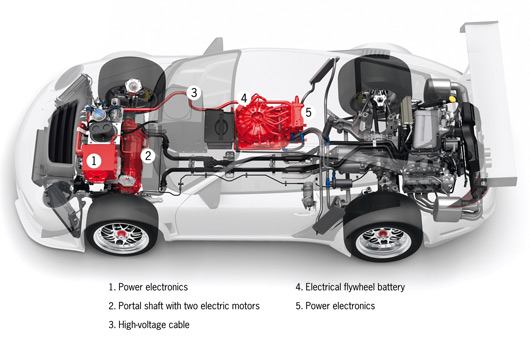Following yesterday’s post about the GT3 R Hybrid comes this official release from Porsche, including high res images which you can access by clicking on the pics you like. Porsche have described this car as a”racing laboratory” so we can expect this to be the first of many hybrid racecar applications from Stuttgart.
As reported the first public showing of the GT3 R Hybrid will be in Geneva, in a little over two weeks time. And, I’m not sure about anyone else, but I am really looking forward to seeing how this car runs in the Nürburgring 24 hour race. Will the KERS-style system provide a true advantage, or will it be a bit of a fizzer?
Oh, there’s a very good reason why the hybrid technology in this GT3 R sounds very similar to the KERS systems used in Formula One. A company called Williams Hybrid Power is behind the gizmo in the Porsche racecar. And, yes, it is that Williams. Seems Sir Frank reckoned he was on to a good thing and bought into to the energy storage system game, even if the technology wasn’t fully embraced at F1 level.
Yep, there’s a brief press statement from Williams Hybrid Power too. You can check out all these goodies after the break, so what are you waiting for…
WILLIAMS HYBRID POWER CONTRACTS WITH PORSCHE AG FOR 911 GT3 R HYBRID
Oxford, UK, February 11, 2010. Williams Hybrid Power Limited is pleased to confirm that the energy storage system as part of the new Porsche 911 GT3 R Hybrid, which was announced today by Dr. Ing. h.c. F. Porsche AG, Stuttgart, has been developed and supplied by Williams Hybrid Power. The 911 GT3 R Hybrid with innovative hybrid drive will make its debut at the Geneva Motor Show. Further details from Porsche follow in the attached press release.
The energy storage system was originally developed for use in Formula One by the AT&T Williams team but Williams Hybrid Power is now focused on applications in road vehicles.
The technology will also be developed for larger, infrastructure applications by Williams F1 at its new research facility in the Qatar Science and Technology Park.
Ian Foley, Managing Director of Williams Hybrid Power said, “We are delighted to see our technology being adopted by one of the world’s leading engineering companies and most prestigious automotive manufacturers in one of their racing cars. Partnering with Porsche on this project has been a very positive experience and we are grateful to them for choosing to work with us.”
Alex Burns, Chairman of Williams Hybrid Power and Chief Operating Officer of Williams F1 said, “This is a milestone for both Williams Hybrid Power and Williams F1. Together we have worked to bring this technology forward to the point where it can be tested in a racing car and deployed in a road car. We hope that this will be just the start of the evolution of hybrid systems developed for Formula One moving across to applications where they can contribute to cleaner and more powerful vehicles.”
Williams Hybrid Power Ltd (WHP) has developed a novel, patented electromechanical composite flywheel system that provides a high-power, cost-effective and environmentally friendly solution for mobile or stationary energy storage and recovery, originally developed for Formula One. Through development of a flywheel for Williams F1’s Kinetic Energy Recovery System, WHP has proved its world-class engineering capabilities in the composite flywheel field as well as radically improving aspects of the technology in the process. WHP is today making the technology available to meet the high-power energy storage needs in a variety of applications including hybrid passenger vehicles, hybrid buses, electric trains, diesel-electric ships and wind power generation. In November 2009, the company announced its involvement in a mild hybrid road car programme with Ricardo, CTG, JCB, Jaguar Land Rover, SKF and Torotrak. The project aims to demonstrate the potential of flywheel-based hybrid systems with the potential for 30 per cent fuel savings (and equivalent reductions in CO2 emissions) at an on-cost of less than £1000, to enable mass-market uptake of hybrid vehicles in price sensitive vehicle applications.
Hybrid Porsche 911 GT3 R to make world debut in Geneva
- Innovative hybrid drive unveiled at Geneva Show prior to racing at the Nurburgring in May
- Development of 911 GT3 racer serves as a spearhead for technology and ‘racing laboratory’
- Showcase for Porsche Intelligent Performance philosophy
A Porsche 911 GT3 R with innovative hybrid drive will be unveiled at the Geneva Motor Show in March, taking the evolution of the iconic sports coupe to new levels in motor sport and opening a new chapter in an illustrious racing record that has witnessed more than 20,000 victories in 45 years.
After its debut in Switzerland, the 911 GT3 R Hybrid will be tested in long-distance races around the Nürburgring, Germany. The highlight of this test programme will be the 24 Hours race around the 14-mile Nürburgring Nordschleife circuit on 15/16 May. However, the focus is not on the 911 GT3 R Hybrid winning the race but rather serving as a spearhead for the technology and a ‘racing laboratory’ that will provide invaluable knowledge and insight on the subsequent use of hybrid technology in road-going Porsche sports cars.
110 years since Ferdinand Porsche – the company’s founder – developed the world’s first car with hybrid drive, the Lohner Porsche Semper Vivus, it is entirely appropriate that Porsche is once again employing this visionary drive concept in a production car-based GT racing programme.
The 911 GT3 R Hybrid
The hybrid technology featured in the 911 GT3 R Hybrid has been developed especially for racing, and is set apart from conventional hybrid systems in its configuration and choice of components. Uniquely, an electrical front axle drive with two electric motors each developing 60 kW supplements the familiar 480 hp (353 kW) four-litre flat-six ‘boxer’ petrol engine at the rear of the 911 GT3 R Hybrid. Consequently, the 911 GT3 R Hybrid has four driven wheels, offering even greater traction and agility.
A further significant point is that instead of the usual batteries of a conventional hybrid-powered road car, this 911 features an electric flywheel power generator – mounted inside the cockpit beside the driver – that delivers energy to the electric motors on the front axle.
The flywheel generator itself is an electric motor – with its rotor capable of spinning at speeds of up to 40,000 rpm – and stores energy mechanically as rotation, or kinetic, energy. The flywheel generator is charged-up whenever the driver applies the brakes, with the two electric motors reversing their function on the front axle and acting themselves as generators.
The driver is able to call upon this extra energy from the charged flywheel generator at his command for competitive advantage, such as when accelerating out of a bend or overtaking. The flywheel generator is slowed down electromagnetically in the generator mode and able to supply up to 120 kW to the two electric motors at the front axle from its resource of kinetic energy. This additional power is available to the driver after each charge process for approximately 6 – 8 seconds.
Energy formerly converted into heat, and thus wasted, upon every application of the brakes is now converted highly efficiently into additional drive power.
Depending on racing conditions, hybrid drive is used in this case not only for extra power, but also to save fuel. This again increases the efficiency and, accordingly, the performance of the 911 GT3 R Hybrid, by reducing the weight of the fuel tank or making pit stops less frequent, for example.
Porsche Intelligent Performance
The 911 GT3 R Hybrid is a perfect example of the Porsche Intelligent Performance philosophy, a principle to be found in every Porsche and defined as more power on less fuel, more efficiency and lower CO2 emissions – on the race track and on the road. Already, customers can buy a Porsche 911 coupe with a six-cylinder 345 bhp engine which can return nearly 30mpg Combined and produces just 225 g/km CO2; a feat unrivalled in its performance class and just one example of the application of Porsche Intelligent Performance to maintain outstanding driving dynamics yet lower running costs and environmental impact.
Devising smart, individual engineering solutions to combine performance and efficiency with everyday usability is something for which Porsche is renowned, and is evident in such developments as lightweight body construction methods, Porsche Ceramic Composite Brakes (PCCB) and the Porsche Doppelkupplungsgetreibe (PDK) double-clutch gearbox.






21 replies on “OFFICIAL: Porsche GT3 R Hybrid”
Yes please.
Wouldn’t be surprised if Porsche have already developed a full-blown electric concept.
[…] 918Â joins the GT3 R Hybrid announced last month. Add in the Cayenne S Hybrid and you now have three Porsche model lines […]
[…] shown in the clip is the 911 GT3 R Hybrid and the Cayenne S Hybrid. Not sure about anyone else, but I am already counting down the days until […]
[…] Racing is also managing the racing debut of the Porsche 911 GT3 R Hybrid. And it would seem they are doing a great job with this emerging technology as the Hybrid came home […]
[…] this year when news broke about the Porsche 911 GT3 R Hybrid there were a few sceptics around suggesting the car would be a triumph of marketing over substance. […]
[…] F1 driver Nico Hülkenberg has driven the Porsche 911 GT3 R Hybrid around the Nürburgring Nordschleife ahead of the third round in the VLN […]
[…] F1 driver Nico Hülkenberg has driven the Porsche 911 GT3 R Hybrid around the Nürburgring Nordschleife ahead of the third round in the VLN […]
[…] on end? Will Chris Harris and his mates bring home a class win in the GT3 RS? And how will that Hybrid 911 […]
[…] it proved a piece of good fortune for the #9 GT3 R Hybrid. This new car from Porsche fought for the lead with the #99 Audi R8 and managed to establish itself […]
[…] race according to various reports. After coming so close to winning the race this year with the 911 GT3R Hybrid the 918 has the pedigree to give an outright victory a big […]
[…] race according to various reports. After coming so close to winning the race this year with the 911 GT3R Hybrid the 918 has the pedigree to give an outright victory a big […]
[…] is a real treat for you, Autocar have just posted a video of Steve Sutcliffe driving the Porsche GT3 R Hybrid. This is the same car that very nearly won the demanding Nürburgring 24 hour race at its first […]
[…] 918Â joins the GT3 R Hybrid announced last month. Add in the Cayenne S Hybrid and you now have three Porsche model lines […]
[…] The Porsche 918 RSR has just been revealed at the Detroit Auto Show. Its body is based on the 918 Spyder, its power inspired by the 911 GT3 R Hybrid. […]
[…] on the pulse with this technology after teaming up with Williams Hybrid Power to produce the GT3 R Hybrid. A car which made everyone stop and take notice when it very nearly won the Nürburgring 24 hour […]
[…] innovative Porsche 911 GT3 R Hybrid won the VLN race at the Ring on the weekend. In doing so it becomes the first hybrid powered […]
[…] race Porsche informs us there will be 33 of their cars taking part. Back for its second year is the 911 GT3 R Hybrid, which came so close to a fairytale debut in 2010. This year, though, race organisers have […]
[…] Also covered are Porsche’s future racing plans, including the return to the LMP1 category at Le Mans and the expansion of hybrid technology developed for the 911 GT3 R Hybrid. […]
[…] Porsche has already made a successful racing debut with its own 911 GT3 R Hybrid it’s no real surprise for Toyota to do the same. On that basis it makes sense to use the […]
[…] remains and powers the rear wheels only. A flywheel accumulator, similar to the system used in the Porsche GT3 R Hybrid, captures power at braking speeds over 120km/h and offers up to 120kW of power for the front […]
[…] this year a 911 GT3R Hybrid came within two hours of winning the Nürburgring 24 hour race at its first attempt. Already […]